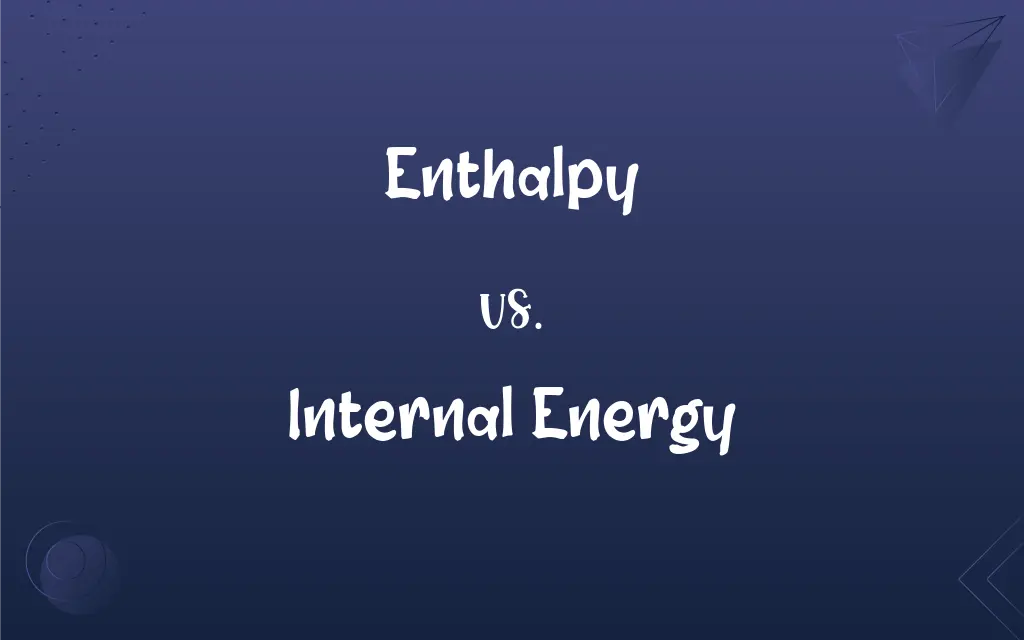Enthalpy vs. Internal Energy: What's the Difference?
Edited by Janet White || By Harlon Moss || Updated on October 25, 2023
Enthalpy represents the total heat content of a system, while internal energy is the energy associated with the random movement of molecules.

Key Differences
Enthalpy and internal energy are fundamental concepts in thermodynamics, vital in understanding energy changes in systems.
It includes not just the energy of the molecules moving and vibrating, but also the energy involved in the breaking and forming of chemical bonds.
In contrast, internal energy, focuses primarily on the energy associated with the random motion of molecules, including translational, rotational, and vibrational energies. It does not account for the energy involved in phase transitions or the energy required for the system to expand or contract against its surroundings.
One key distinction between enthalpy and internal energy lies in how they relate to heat and work in a system.
Enthalpy is especially useful when discussing processes at constant pressure, like most chemical reactions. On the other hand, internal energy provides a more generalized picture of energy changes in a system, irrespective of external pressures or volumes. It’s important to remember that neither enthalpy nor internal energy can be measured directly; only their changes can be observed.
ADVERTISEMENT
Comparison Chart
Definition
Total energy content of a system
Energy related to random motion of molecules
Components
Includes chemical bond energies
Excludes bond formation or breaking energies
Relation to Heat and Work
Change equals heat transfer at constant pressure
Change relates to both heat and work
Typical Uses
Processes at constant pressure like chemical reactions
General energy changes, irrespective of pressure or volume
Direct Measurement
Neither can be measured directly, only changes are observed
Neither can be measured directly, only changes are observed
ADVERTISEMENT
Enthalpy and Internal Energy Definitions
Enthalpy
The total heat content of a system.
During an exothermic reaction, the enthalpy of the system decreases.
Internal Energy
Energy due to the random motion of molecules.
Rising temperature increases the internal energy of a system.
Enthalpy
Sum of internal energy and product of pressure and volume.
Enthalpy is used in calorimetry to measure heat flow.
Internal Energy
Sum of all microscopic forms of energy in a system.
The internal energy decreases in an exothermic process.
Enthalpy
Energy measure that combines internal energy and work.
The change in enthalpy helps us determine the heat of a reaction.
Internal Energy
A state function reflecting energy changes in a system.
The first law of thermodynamics describes how internal energy varies with heat and work.
Enthalpy
Represents heat flow in processes at constant pressure.
For many chemical reactions, the enthalpy change is a crucial parameter.
Internal Energy
Total energy stored within the boundaries of a system.
When a gas is compressed, its internal energy increases due to molecular interactions.
Enthalpy
Thermodynamic potential measuring total energy of a system.
Enthalpy changes give insights into the energy changes during phase transitions.
Internal Energy
Related to the kinetic and potential energies of particles.
Molecular vibrations and rotations contribute to the system's internal energy.
Enthalpy
Symbol H A thermodynamic function of a system, equivalent to the sum of the internal energy of the system plus the product of its volume multiplied by the pressure exerted on it by its surroundings.
Enthalpy
A measure of the heat content of a chemical or physical system.
, where H is enthalpy, U is internal energy, p is pressure, and V is volume.
Enthalpy
(thermodynamics) a thermodynamic quantity equal to the internal energy of a system plus the product of its volume and pressure;
Enthalpy is the amount of energy in a system capable of doing mechanical work
FAQs
Is enthalpy always related to heat?
At constant pressure, the change in enthalpy equals the heat transferred.
What contributes to the internal energy of a system?
It includes translational, rotational, and vibrational energies of molecules.
Does the internal energy change with temperature?
Yes, as temperature increases, internal energy typically rises.
How is enthalpy related to the internal energy?
Enthalpy is the sum of internal energy and the product of pressure and volume.
Can we directly measure enthalpy or internal energy?
No, only their changes can be measured or observed.
When is enthalpy most commonly used?
For processes at constant pressure, especially in chemical reactions.
What does a negative change in enthalpy indicate?
It indicates an exothermic process or reaction.
Can the internal energy determine if a reaction is spontaneous?
No, spontaneity is determined by the Gibbs free energy, not just internal energy.
Why is enthalpy useful in understanding chemical reactions?
It provides insights into the heat flow and energy changes in reactions.
What factors affect the internal energy of a system?
Temperature, volume, and number of particles are some factors.
Can a system have zero internal energy?
Theoretically, at absolute zero temperature, a system would have minimal internal energy.
Is the internal energy a state function?
Yes, it only depends on the current state, not the path taken to reach it.
Are enthalpy and entropy related?
While both are state functions, they represent different thermodynamic quantities.
Do all reactions involve a change in enthalpy?
Most reactions involve enthalpy changes, though some might have negligible changes.
Can the internal energy be negative?
Internal energy is always a positive quantity, but its change can be negative.
What is the relation between internal energy and the first law of thermodynamics?
The first law describes how internal energy changes with heat and work.
Does increasing volume always increase internal energy?
Not necessarily; the relationship depends on the nature of the system and process.
Is enthalpy a scalar or vector quantity?
Enthalpy is a scalar quantity.
Why is the change in enthalpy important in chemistry?
It helps determine if reactions are endothermic or exothermic.
How is enthalpy used in calorimetry?
Enthalpy changes represent the heat flow measured in calorimetry.
About Author
Written by
Harlon MossHarlon is a seasoned quality moderator and accomplished content writer for Difference Wiki. An alumnus of the prestigious University of California, he earned his degree in Computer Science. Leveraging his academic background, Harlon brings a meticulous and informed perspective to his work, ensuring content accuracy and excellence.
Edited by
Janet WhiteJanet White has been an esteemed writer and blogger for Difference Wiki. Holding a Master's degree in Science and Medical Journalism from the prestigious Boston University, she has consistently demonstrated her expertise and passion for her field. When she's not immersed in her work, Janet relishes her time exercising, delving into a good book, and cherishing moments with friends and family.
































































